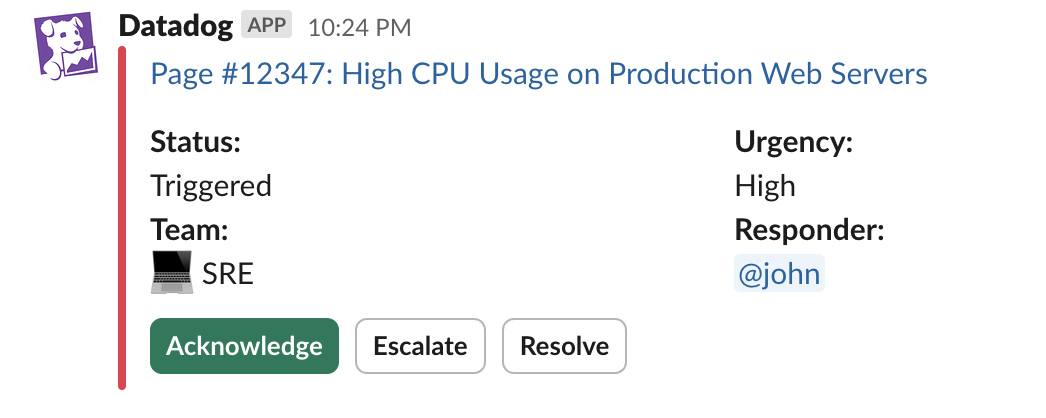- Essentials
- Getting Started
- Agent
- API
- APM Tracing
- Containers
- Dashboards
- Database Monitoring
- Datadog
- Datadog Site
- DevSecOps
- Incident Management
- Integrations
- Internal Developer Portal
- Logs
- Monitors
- Notebooks
- OpenTelemetry
- Profiler
- Search
- Session Replay
- Security
- Serverless for AWS Lambda
- Software Delivery
- Synthetic Monitoring and Testing
- Tags
- Workflow Automation
- Learning Center
- Support
- Glossary
- Standard Attributes
- Guides
- Agent
- Integrations
- Developers
- Authorization
- DogStatsD
- Custom Checks
- Integrations
- Build an Integration with Datadog
- Create an Agent-based Integration
- Create an API-based Integration
- Create a Log Pipeline
- Integration Assets Reference
- Build a Marketplace Offering
- Create an Integration Dashboard
- Create a Monitor Template
- Create a Cloud SIEM Detection Rule
- Install Agent Integration Developer Tool
- Service Checks
- IDE Plugins
- Community
- Guides
- OpenTelemetry
- Administrator's Guide
- API
- Partners
- Datadog Mobile App
- DDSQL Reference
- CoScreen
- CoTerm
- Remote Configuration
- Cloudcraft (Standalone)
- In The App
- Dashboards
- Notebooks
- DDSQL Editor
- Reference Tables
- Sheets
- Monitors and Alerting
- Watchdog
- Metrics
- Bits AI
- Internal Developer Portal
- Error Tracking
- Change Tracking
- Service Management
- Service Level Objectives
- Incident Management
- On-Call
- Status Pages
- Event Management
- Case Management
- Actions & Remediations
- Infrastructure
- Cloudcraft
- Resource Catalog
- Universal Service Monitoring
- End User Device Monitoring
- Hosts
- Containers
- Processes
- Serverless
- Network Monitoring
- Storage Management
- Cloud Cost
- Application Performance
- APM
- Continuous Profiler
- Database Monitoring
- Agent Integration Overhead
- Setup Architectures
- Setting Up Postgres
- Setting Up MySQL
- Setting Up SQL Server
- Setting Up Oracle
- Setting Up Amazon DocumentDB
- Setting Up MongoDB
- Connecting DBM and Traces
- Data Collected
- Exploring Database Hosts
- Exploring Query Metrics
- Exploring Query Samples
- Exploring Database Schemas
- Exploring Recommendations
- Troubleshooting
- Guides
- Data Streams Monitoring
- Data Jobs Monitoring
- Data Observability
- Digital Experience
- Real User Monitoring
- Synthetic Testing and Monitoring
- Continuous Testing
- Product Analytics
- Software Delivery
- CI Visibility
- CD Visibility
- Deployment Gates
- Test Optimization
- Code Coverage
- PR Gates
- DORA Metrics
- Feature Flags
- Security
- Security Overview
- Cloud SIEM
- Code Security
- Cloud Security
- App and API Protection
- Workload Protection
- Sensitive Data Scanner
- AI Observability
- Log Management
- Administration
Routing Rules
This product is not supported for your selected Datadog site. ().
Overview
With routing rules, you can define granular logic to control how alerts reach your team. Instead of sending alerts through a single escalation policy, you can create flexible, condition-based rules to route them based on priority, time of day, tags, and more.
Routing rules examples
Route alerts by priority:
- Send priority 1 alerts to your primary escalation policy.
- Send priority 2–4 alerts to Slack or Microsoft Teams.
Route alerts by time of day:
- During business hours, route alerts to an escalation policy.
- After hours, route critical alerts to paging, and non-critical alerts to chat.
Use Dynamic Urgency to automatically detect urgency from the monitor alert:
warnstatus ➝ low urgencyalertstatus ➝ high urgency
The urgency of a page determines how end users are notified, based on their preferences.
Trigger workflows (coming soon): Use routing rules to trigger automated workflows in response to matching alerts.
Send Pages to Slack or Microsoft Teams
When you route Pages to Slack or Microsoft Teams, Datadog sends a notification to the configured channel and creates a corresponding Page object in the On-Call platform. From Slack, team members can use interactive buttons to acknowledge, resolve, escalate, or declare an incident. This streamlines incident response without leaving the chat environment.
When a Page is acknowledged or resolved in Slack, Datadog updates the original notification in place, without sending additional messages. This keeps responders focused by reducing noise and showing the current Page status directly in the original thread.
Routing rule syntax
Routing rules use Datadog query syntax and support multiple if/else conditions. Rules are evaluated from top to bottom, and the final rule must act as a fallback that routes all unmatched alerts to an escalation policy.
Routing rule syntax is case-sensitive. For example, `tags.env:Prod` will not match `tags.env:prod`.
Supported attributes:
| Attribute | Description | Example |
|---|---|---|
tags | Tags on the incoming alert | tags.env:prod |
groups | Monitor group names | groups.service:checkout-service |
priority | Monitor priority (1–5) | priority:(1 OR 2) |
alert_status | Monitor status (error, warn, success) | alert_status:(error OR warn) |
Best practices
- Balance visibility with urgency:
- Use paging and escalation policies for critical alerts that require immediate action.
- Use Slack or Teams for lower-severity issues that need awareness but don’t warrant an on-call response.
Further reading
Additional helpful documentation, links, and articles:


